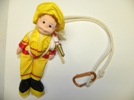
FALLS: Overcoming Gravity
Make the training interesting. Get your employees engaged and keep them safe.
Superman came from the planet Krypton. It has a force of gravity that is greater than the gravity here on earth and, because of that, Superman is "able to leap tall buildings in a single bound" and come down safely. You and your employees, however, need some protection. Ensuring that those employees use that protection, always, is our task.
In this article, I would like to present you with some techniques that can help you develop some training to keep your employees engaged when you need to talk about fall protection.
What do the following numbers have in common?
4'
6'
10'
15'
So what did you come up with?
These are OSHA's requirements for when guarding and/or fall protection is required:
1910.23(b)(1): Every wall opening from which there is a drop of more than 4 feet shall be guarded....
1926.501(b)(1): "Unprotected sides and edges." Each employee on a walking/working surface (horizontal and vertical surface) with an unprotected side or edge which is 6 feet or more above a lower level shall be protected from falling....
1926.451(g)(1): Each employee on a scaffold more than 10 feet above a lower level shall be protected from falling to that lower level.
1926.760(a)(1): [Steel Erection] ... each employee engaged in a steel erection activity who is on a walking/working surface with an unprotected side or edge more than 15 feet above a lower level shall be protected from fall hazards by guardrail systems, safety net systems, personal fall arrest systems, positioning device systems or fall restraint systems.
1926.1423(f): [Cranes] For assembly/disassembly work, the employer must provide and ensure the use of fall protection equipment for employees who are on a walking/working surface with an unprotected side or edge more than 15 feet above a lower level....
A – B – C – D
How easily do your employees remember all of the components they need for a correct fall protection system? It’s as easy as A-B-C-D.
DBI-SALA/Capital Safety says:
- A: Anchorage -- each anchor point needs to support 5,000 pounds per person
- B: Body support -- full-body harness that is correctly sized to the employee
- C: Connector -- shock-absorbing lanyard or self-retracting lifeline
- D: Descent/rescue -- in the event of an incident, how does your employee get to safety?
(DBI-SALA's A-B-C-D, http://en.capitalsafety.us/USTools/USABCsofFallProtection/tabid/1706/language/en-US/Default.aspx)
Splat!
With a typical 6-foot lanyard and a harness, what's the minimum height where this type of equipment will work and protect your employee?
Miller Fall Protection Company says you need to take the following items into account for calculating the minimum fall distance:
- Length of anchorage connector
- Length of connecting device (lanyard, typically 6 feet)
- Maximum elongation/deceleration distance
- Harness stretch/sliding back D-ring movement
- Height measured to worker's harness back D-ring
- Safety factor
(Miller Fall Protection's calculation for fall protection, http://www.millerfallprotection.com/smart-solutions/connecting-devices/calculating-fall-clearance-3)
What's your calculation? Did you get 18.5 feet? If your employees are working at less than that distance, then you need to make some changes to the equipment. Use a 4-foot lanyard or use a self-retracting lanyard instead.
How do you show this to your employees ... safely? You can get a SPLAT indicator from your Miller distributor or make one of your own. Use a small weight and 18.5 feet of string. Fasten the end of the string to the anchor point and drop the weight. If it hits the ground, splat! Your anchor point is too low for a standard set-up. You will need to change something. Raise your anchor point or shorten your lanyard.
Let’s Play with Dolls
How can you show what a swing fall is without falling? How can you show what a splat looks like without getting hurt?
Play with dolls. The doll pictured in this article was found in a dollar store, and all I did was tie some rope to simulate the harness and lanyard. I used a key-ring (toy) carabiner to simulate the anchoring snap-hook. Put a tack in the wall, move the doll more than 30 degrees to the side, and let go. Put you hand under the tack and show that the employee could hit the wall (your hand) if he or she had a swing fall.
Inspection
Regardless of what other techniques you use in your training courses, don't forget to train your employees in how to properly inspect their fall protection equipment. The manufacturer of your equipment should be able to provide you with inspection requirements. Don't forget to document your inspection by marking the tags attached to the equipment and/or filling out an inspection report form.
This inspection needs to be performed by a competent person at least on an annual basis. If the equipment was used in an actual fall event, it should be removed from service until it can be determined whether it is safe to use or should be replaced.
Make the training interesting. Get your employees engaged and keep them safe.
Additional Background Information
OSHA's Fall Protection website: http://www.osha.gov/SLTC/fallprotection/index.html
OSHA Trade News: OSHA announces three-month phase-in for residential construction fall protection, June 9, 2011: http://www.osha.gov/pls/oshaweb/owadisp.show_document?p_table=NEWS_RELEASES&p_id=19974
This article originally appeared in the January 2012 issue of Occupational Health & Safety.